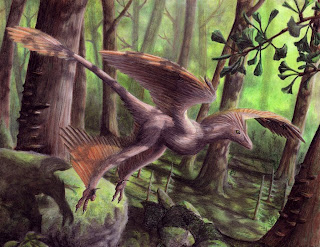 And here's number six. Epidexipteryx is a fairly recent discovery from the mid or upper Jurassic-age Daohugou Beds of Inner Mongolia, China, and is a maniraptoran of the same family as Epidendrosaurus, on which the speculative third digit is based.
And here's number six. Epidexipteryx is a fairly recent discovery from the mid or upper Jurassic-age Daohugou Beds of Inner Mongolia, China, and is a maniraptoran of the same family as Epidendrosaurus, on which the speculative third digit is based.What makes Epidexipteryx unique is its tail, which sported several long, flat feathers anchored to a skeletal structure similar in nature to the modern pygostyle of birds. The tail feathers appear very primitive and completely lack barbs, and instead are like long, flat sheets of keratin supported by a central rachis.
This is conte crayon on paper. August 2009.





